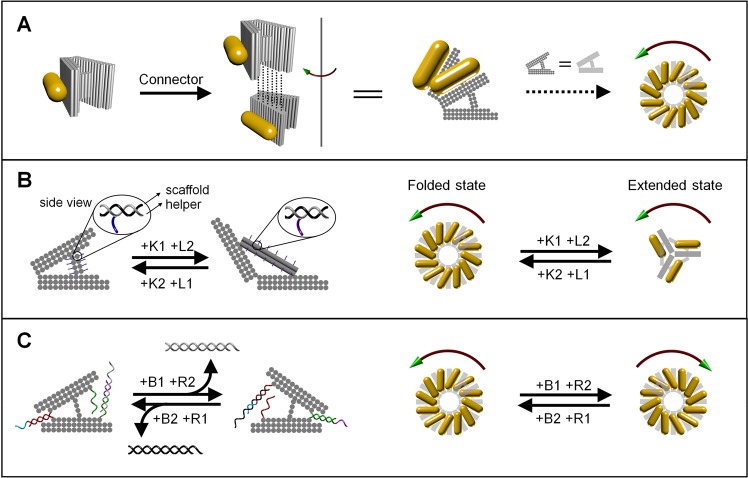Figure 1.
Schematic illustration of the principle of self-assembly and structural reconfiguration of the chiral plasmonic superstructures of AuNR. (A) AuNRs (12 nm × 38 nm) functionalized with V-shaped DNA origami are hierarchically self-assembled into a left-handed chiral superstructure (a stair helix with a pinwheel bottom-view), through DNA hybridization with connector strands at corresponding locations as indicated by the dashed lines. (B) DNA origami is dynamically converted between a tightly folded state and an extended state to make the reconfiguration of AuNR superstructure possible. The reconfiguration between these two states occurs via a toe-hold-mediated strand displacement reaction. Key strands and lock strands [(K1 and L2) or (K2 and L1)] are added in an alternating fashion to create the structural transformation. Each arm of the DNA origami is 36 nm in width, 24 nm along the helical axis, and 7.8 nm in thickness. The DNA spacer in the tightly folded state (left) is a 2 × 4 helix bundle with the DNA helical axis parallel to the helical direction of the arms that separates the two arms at an angle of approximately 30°. In the extended state (right) the spacer is structurally switched into a 2 × 2 helical bundle with the helical axis perpendicular to the helical direction of the arms that separates the two arms at an angle of ∼120°. (C) The DNA origami is designed to allow the dynamic conversion between the two mirror-image like structures, which enables the handedness inversion of the AuNR superstructure. The design of the DNA origami is similar to that in (B), but with a fixed 4 helix bundle in the middle as the spacer. The hinge of the V-shape is closed by a zipping hybridization of the two DNA handles (there are actually two pairs; only one pair is shown here) and opened by a toe-hold-mediated strand displacement. A combination of block strands and release strands [(B1 and R2) or (B2 and R1)] are added in an alternating fashion to make the structural transformation. The interarm angle is approximately 40° in both cases, taking into account the flexibility of the double helix connections at the hinges. A slightly larger angle for the right V-shape is expected as the 4 helix bundle linker between the two arms is not in the exact center position.

